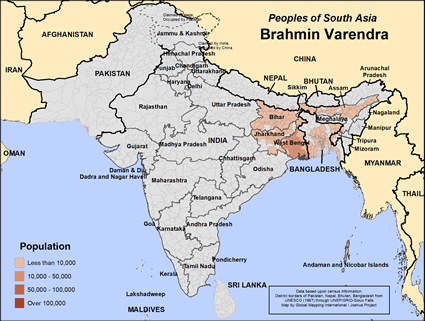Brahmin Varendra in Bangladesh

Photo Source:
Biswarup Ganguly - Wikimedia
Creative Commons
|

Map Source:
People Group Location: Omid. Other geography / data: GMI. Map Design: Joshua Project
|
| People Name: | Brahmin Varendra |
| Country: | Bangladesh |
| 10/40 Window: | Yes |
| Population: | 21,000 |
| World Population: | 289,000 |
| Primary Language: | Bengali |
| Primary Religion: | Hinduism |
| Christian Adherents: | 0.00 % |
| Evangelicals: | 0.00 % |
| Scripture: | Complete Bible |
| Ministry Resources: | Yes |
| Jesus Film: | Yes |
| Audio Recordings: | Yes |
| People Cluster: | South Asia Forward Caste - Brahmin |
| Affinity Bloc: | South Asian Peoples |
| Progress Level: |
|
Introduction / History
Brahmins are the highest of the four varna (major caste groupings) in Hinduism. The historical developments of various Brahman castes are not clear, as the history of the caste system itself is unclear. There was perhaps a caste system based on personal merit at one time before the hereditary caste system became dominant, as is seen in modern history. Brahman castes became powerful in the early centuries of the Christian Era through alliances with kings, who granted them landed estates related to temples and temple service. There has never been a comprehensive analysis of all the different types and subgroups of Brahmans, but to the best of our knowledge, one of the subgroups is the Varendra community.
Traditionally Brahmins have five daily duties; to the gods, to ancestors, to all creatures, to humans, and to study. Thus daily worship (duty to gods) and chanting of sacred texts (duty to study) are an integral part of many Brahmans' lives, even if this is only a token routine for many.
Where Are they Located?
Varendra is a region that straddles India's state of West Bengal and the northwestern part of Bangladesh. These Brahmans are named after their region of origin. Most of them moved to India's West Bengal during the upheaval of partition of India in 1947.
What Are Their Lives Like?
Traditionally in the varna system Brahmans are considered as priests, but a temple priest is a lowly position that no Varendra Brahman family wants their sons to aspire towards. Rather, there is strong pressure for higher education, particularly in computer science and engineering. Varendra Brahmans have a strong work ethic and are often leaders, whether politically, intellectually, spiritually or socially.
Varendra Brahmins are deeply influenced by the traditional four stages of life; the first student stage is followed by the householder stage, where marriage, raising a family and being a productive member of society is the primary obligation of an individual. Once children are married there is time for spiritual concerns in the third stage of reclusiveness, which is followed (this is rarely practiced) by itinerant homeless wandering (sannyasa).
Often a busy Brahmin will put off spiritual discussions as an issue for later in life. The famous Bhagavad Gita text does not support this, however, as it calls for all humanity to engage in doing good to all without thought of merit or reward for such actions.
What Are Their Beliefs?
In some cases Brahmin subgroups are defined by their theological distinctions such as Madhva Brahmins, who are defined by their dualist theology, though everyone does not actually hold those beliefs. However, many Brahman castes are made up of people who adhere to all the various philosophical and theological options espoused by modern Hindus, including hard core secularists and atheists. One can never predict what an individual Brahmin might believe or disbelieve!
What Are Their Needs?
Varendra Brahmins as an influential and generally well-to-do community are not unlike the middle classes of most places. Their main needs involve relational strains that are usually kept behind closed doors. Modernization is breaking down family units which have been the glue to society for many generations, and loneliness is increasingly a problem. They are expected to "achieve it all," but ironically, achieving it all can be empty.
Like other Brahman peoples, the Varendras feel that turning their allegiance to another religious system will jeopardize their status. For this reason, they are very reluctant to give their allegiance to Jesus Christ, believing this is tantamount to joining a different religious system. But as yet, no one has thought it possible to allow them to maintain their Hindu culture while turning their allegiance to Jesus Christ alone.
Prayer Points
Pray that the Holy Spirit will raise up believers who will actively introduce the Varendra Brahmins to Jesus Christ and help them to worship Him in culturally-appropriate ways that will glorify His Name.
Pray for Christ to reveal Himself to Varendra Brahmin leaders.
Pray for a disciple making movement to emerge among every Brahmin community.
Pray for many to be prompted to faithfully pray for Varendra Brahmins.